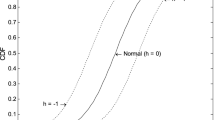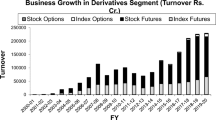Abstract
This paper investigates the pricing of Nikkei 225 Options using the Markov Switching GARCH (MSGARCH) model, and examines its practical usefulness in option markets. We assume that investors are risk-neutral and then compute option prices by using Monte Carlo simulation. The results reveal that, for call options, the MSGARCH model with Student’s t-distribution gives more accurate pricing results than GARCH models and the Black–Scholes model. However, this model does not have good performance for put options.
Similar content being viewed by others
References
Bakshi G., Cao C., Chen Z. (1997) Empirical performance of alternative option pricing models. Journal of Finance 52: 2003–2049
Bauwens L., Lubrano M. (1998) Bayesian inference on GARCH models using the Gibbs sampler. Econometrics Journal 1: C23–C46
Bauwens L., Lubrano M. (2002) Bayesian option pricing using asymmetric GARCH models. Journal of Empirical Finance 9: 321–342
Bera A. K., Higgins M. L. (1993) On ARCH models: Properties, estimation and testing. Journal of Economic Surveys 7: 305–366
Black F., Scholes M. (1973) The pricing of options and corporate liabilities. Journal of Political Economy 81: 637–654
Bollerslev T. (1986) Generalized autoregressive conditional heteroskedasticity. Journal of Econometrics 31: 307–327
Bollerslev, T., Engle, R. F., & Nelson, D. B. (1994). ARCH models. In R. F. Engle & D. McFadden (Eds.), The handbook of econometrics, Vol. 4, (pp. 2959–3038). North-Holland.
Cai J. (1994) A Markov model of switching-regime ARCH. Journal of Business & Economic Statistics 12: 309–316
Diebold F. X. (1986) Modeling the persistence of conditional variances: A comment. Econometric Reviews 5: 51–56
Duan J.-C. (1995) The GARCH option pricing model. Mathematical Finance 5: 13–32
Duan, J.-C. (1999). Conditionally fat-tailed distributions and the volatility smile in options. Working Paper, University of Toronto.
Duan J.-C., Zhang H. (2001) Pricing Hang Seng index options around the Asian financial crisis—A GARCH approach. Journal of Banking & Finance 25: 1989–2014
Elliott R. J., Siu T. K., Chan L. (2006) Option pricing for GARCH models with Markov switching. International Journal of Theoretical & Applied Finance 9: 825–841
Engle R. F. (1982) Autoregressive conditional heteroskedasticity with estimates of the variance of United Kingdom inflation. Econometrica 50: 987–1007
Engle R. F., Mustafa C. (1992) Implied ARCH models from options prices. Journal of Econometrics 52: 289–311
Garcia R. (1998) Asymptotic null distribution of the likelihood ratio test in Markov switching models. International Economic Review 39: 763–788
Gray S. F. (1996) Modeling the conditional distribution of interest rates as a regime-switching process. Journal of Financial Economics 42: 27–62
Haas M., Mittnik S., Paolella M. S. (2004) A new approach to Markov-switching GARCH models. Journal of Financial Econometrics 2: 493–530
Hamilton J. D., Susmel R. (1994) Autoregressive conditional heteroskedasticity and changes in regime. Journal of Econometrics 64: 307–333
Hansen B. E. (1992) The likelihood ratio test under nonstandard conditions: Testing the Markov switching model of GNP. Journal of Applied Econometrics 7: S61–S82
Hansen B. E. (1996) Erratum: The likelihood ratio test under nonstandard conditions: Testing the Markov switching model of GNP. Journal of Applied Econometrics 11: 195–198
Kim C.-J., Nelson C. R. (1999) State-space models with regime switching: Classical and Gibbs-Sampling approaches with applications. MIT Press, Cambridge, MA
Klaassen F. (2002) Improving GARCH volatility forecasts with regime-switching GARCH. Empirical Economics 27: 363–394
Lamoureux C. G., Lastrapes W. D. (1990) Persistence in variance, structural change, and the GARCH model. Journal of Business & Economic Statistics 8: 225–234
Mitsui H. (2000) An analysis of Nikkei 225 option pricing by a GARCH model. Gendai-Finance 7: 57–73 (in Japanese)
Mitsui H., Watanabe T. (2003) Bayesian analysis of GARCH option pricing models. Journal of the Japan Statistical Society 33: 307–324 (in Japanese)
Moriyasu H. (1999) Valuing the Nikkei 225 option using the ARCH option pricing method. Studies in Contemporary Economics 7: 143–159 (in Japanese)
Noh, J., Engle, R. F., & Kane, A. (1994). Forecasting volatility and option pricing of the S&P500 index. Journal of Derivatives, pp. 17–30.
Sabbatini M., Linton O. (1998) A GARCH model of the implied volatility of the Swiss market index from option prices. International Journal of Forecasting 14: 199–213
Saez M. (1997) Option pricing under stochastic volatility and interest rate in the Spanish case. Applied Financial Economics 7: 379–394
Satoyoshi K. (2004) An empirical study of volatility in the Japanese stock market using the Markov switching GARCH model. Journal of the Japan Statistical Society 34: 1–19 (in Japanese)
Siu T. K., Tong H., Yang H. (2004) On pricing derivatives under GARCH models: A dynamic Gerber-Shiu approach. North American Actuarial Journal 8(3): 17–31
Taylor S. J. (1986) Modelling financial time series. John Wiley & Sons, Chichester
Watanabe T. (2003) An analysis of the GARCH option pricing model using the Nikkei 225 option data (in Japanese). Kinyu-Kenkyu 22: 1–34
Watanabe, T., & Ubukata, M. (2009). Option pricing using realized volatility and ARCH type models. Global COE Hi-Stat Discussion Paper Series 066, Hitotsubashi University.
Author information
Authors and Affiliations
Corresponding author
Rights and permissions
About this article
Cite this article
Satoyoshi, K., Mitsui, H. Empirical Study of Nikkei 225 Options with the Markov Switching GARCH Model. Asia-Pac Financ Markets 18, 55–68 (2011). https://doi.org/10.1007/s10690-010-9120-6
Published:
Issue Date:
DOI: https://doi.org/10.1007/s10690-010-9120-6




